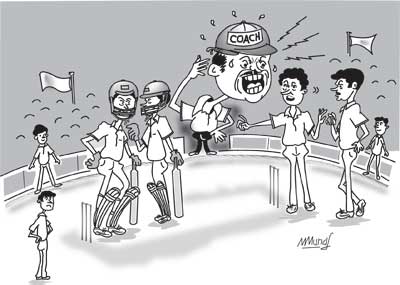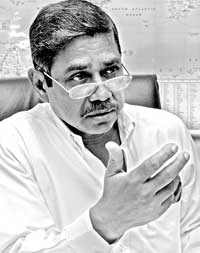
Is over coaching bane of Sri Lankan junior cricket?
For the last few seasons we have been pointing fingers at the custodians of our junior cricket and shouting our throats dry saying “Hey! Look here the building is collapsing”.
However this time we here at The Sunday Musings decided to take a more meaningful step and really find out if and how Sri Lanka Cricket is looking at this whole perspective and what measures they are taking to stem the rot. So to enlighten us on this issue we went to none other than the director Cricket Operations SLC – Bandula Warnapura under whose wing the entire cricket structure of Sri Lanka runs. Frank in his disposition, Warnapura was not hesitant to admit there was something a miss in this whole cavalcade. He said “There is a problem of over coaching. The boys are not allowed to take their own decisions. From under thirteen to first eleven who controls the game? It is the coach who is directing the game from the boundary line. He will keep walking around giving orders setting the field and making bowling changes. In this scenario are we educating the child? Are we teaching him to take his own decisions? During our time our coaches never interfered besides a small chit that comes during the water break or a little piece of his mind after the inning is over, if we had done something wrong. That’s how we learned our basics and leadership skills on the field. We were allowed to be independent to take our own decisions. “Now we have planned to put a stop to all this. Have you noticed in soccer there is a small area that is demarcated to the coach and he is not allowed to be anywhere else in the peripheries while the match is in progress! At the same time if the umpires feel that the coach is disturbing the players while the game is in progress they could put it down in their match report so that the authorities could act upon them. This is where the coaches’ licences are coming in. We are hoping to introduce a licensing scheme to all the coaches who are involved in school cricket. They will be in two categories. The ‘A’ category coaches could take on any cricket playing school, while the coaches who in the ‘B’ category could only take on some specified schools. Now when we issue these coaches with their licences we will clearly demarcate their peripheries. If we find that they are breaching them first we will advice them and tell them to adhere to the rules and if we still get complaints about the conduct of these individuals, we will be compelled to blacklist them. Once they are blacklisted they can not coach any schools that come under the system.”
Elaborating further on that point Warnapura continued “Now during the last under 19 ties against India and Bangladesh we noticed that none of the bowlers were willing to set their own fields. I feel not that they did not know what their field should be, but, so much of interference during their school career had nullified this ability in them. At present no coach likes to lose. So they play safe. The difference between our times and now is that cricket is inculcated in the schools sphere in a very negative manner. If you win on the first innings you get points on that, and we have learned that some coaches when they want points to get to the next stage of the tournament they get to a place where no one will notice and exploit the situation so that the necessary party would be through to the next round.” Then came the constructive part. Warnapura added “To combat this situation we have mooted another system. If a school produces a national cricketer who goes on to represent the country on a regular basis the SLC will help the school to a maximum of four million rupees worth of help in building up infrastructure. If the boy has represented two schools, both schools will get equal shares of this sum. At the same time to make a cricketer more effective we are looking into areas of even cutting down on inter-district cricket and concentrate more on inter-provincial cricket.” Then Warnapura went on to explain about the structure the junior cricket is now based upon and how the machinery works “As soon as the interschool season is over in the age groups of under 13 to 19 within two weeks we play the district cricket tournament. Then in the next step we go to the inter-provincial tournament excluding the under thirteen, because we feel school cricket and district cricket is sufficient for them. First we wait till the SLSCA conducts its tournaments. Then we play the inter-district and the inter-provincial tournaments to form the national development squads. Rather than conducting trial matches those players who come into the national development squads have come there through a certain given criteria.” Director Cricket Operations then explained the criteria on how the players are drafted into the respective squads “We have a software programme where we collect all data of players through the score sheets that is sent to us during the season. Then we assess them and send these back to the respective principals for certification. Meanwhile the district coaches are given the task of identifying the cricketers while witnessing the matches. Then when the coaches sit every month here at the SLC they discuss the players whom they have identified. This way we have a good cross check of all players. “At the same time they also have to report about the facilities that are available at various venues too. So we also keep a check on the facilities available in schools. We have got an approval of Rs.250 million to be utilized for the development of cricket over the next five years. This money will be used for the development of basic facilities of cricket infrastructure in schools. What we are looking at is practice Astro-turfs which lasts at least a period of five years and the cost of each of these wickets is about 500,000 rupees. Any team that is taking part in the SLSCA conducted tournaments are eligible to get these facilities. Then if the schools have the facility even to conduct cricket upto the under 17 level then they are eligible to get a centre astro turf. To get these facilities the principal must write to the SLC and make a request. In the 2006-7 season itself we have given 94 side turfs, 34 centre wickets. This paper was prepared with the assistance of the SLSCA. Then for the next season we have earmarked 61 centre wickets and 120 side wickets. “Then there some other schools who have requested for other facilities also and these will be looked into once we complete the basic programme in 2008. “We have already spent about 60 million in 2007 and we hope to spend another 100 million in 2008 and we might be able to get other areas of facility development by 2009. Details of these activities also have been sent to the ministry of education. “Besides this programme we have also delved into the aspects of school grounds where there are facilities, but need further development. During the Under 19 World Cup we used some school grounds so what do we give them in return? They could give the grounds to us because they had been maintaining them to a certain standard. Then comes the schools that have already produced cricketers to the national team. For instance Ananda has produced the highest number of national cricketers. They made a proposal to us and we gave them 7.5 million and they are also pumping in about Rs.10 million and there is a huge development programme going on there. Besides this, schools like Prince of Wales, S. Thomas’ St. Peter’s, Royal, Wesley and St. Benedict’s are also been given assistance with sprinkler systems so that they get over their labour shortages. .We are also going to install sprinkler systems at Trinity College Grounds and St. Anthony’s College Grounds Kandy too. These grounds which are being developed will host Board matches and also they have produced a large number of national cricketers.” Said Warnapura in conclusion. |
|| Front
Page | News | Editorial | Columns | Sports | Plus | Financial
Times | International | Mirror | TV
Times | Funday
Times || |
| |
Reproduction of articles permitted when used without any alterations to contents and the source. |
© Copyright
2007 Wijeya
Newspapers Ltd.Colombo. Sri Lanka. All Rights Reserved. |
 It is a very human habit to forget problems at hand and get distracted by the current newsmakers till the problem will swing back once again and hit you harder than before.
It is a very human habit to forget problems at hand and get distracted by the current newsmakers till the problem will swing back once again and hit you harder than before. 
